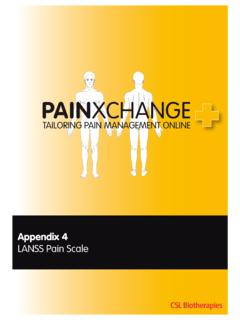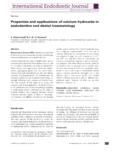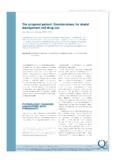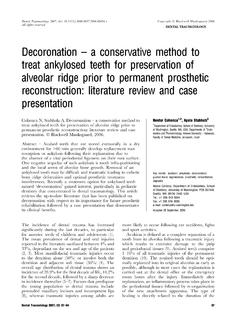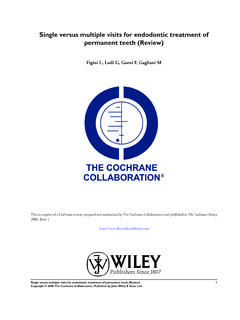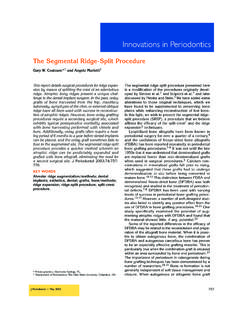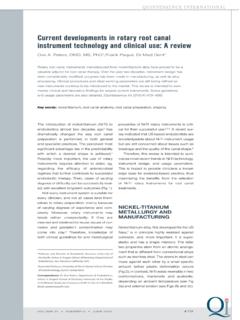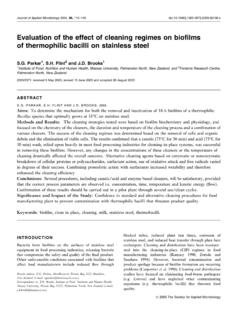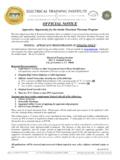Transcription of Local Anesthetics in Dentistry - EndoExperience
1 1 Local Anesthetics in Dentistry : Then and Now Local Anesthetics have been in use in dental practice for more than 100 years. The advent of Local Anesthetics with the development of nerve blockade injection techniques heralded a new era of patient comfort while permitting more extensive and invasive dental procedures. A brief history and summary of the current Local Anesthetics available in the United States is provided, and some of the newest techniques for delivering Local Anesthetics are reviewed. General guidelines for addressing difficulties encountered in anesthetizing patients are also discussed. The first Local anesthetic agent to be widely used in Dentistry was cocaine. Centuries before European exploration of the New World, Peruvian Indians had found that chewing leaves of the coca plant produced exhilaration and relief from fatigue and hunger.
2 Following the import of coca leaves to Europe, much research was conducted to elucidate the properties of the coca leaf extract. In 1859, Albert Niemann refined the coca extract to the pure alkaloid form and named this new drug cocaine. Niemann recognized the anesthetic effect of cocaine when he noted that it benumbs the nerves of the tongue, depriving it of feeling and taste. 1 In the summer of 1884, Carl Koller, a junior resident in the University of Vienna Ophthalmological Clinic, conducted experiments to test the topical anesthetic properties of cocaine on the corneas of various lab animals and on himself (self-administration being common in medical research at that time). He found that the drug rendered the corneas insensitive to pain.
3 In September of that year, Koller performed the world s first operation using Local anesthesia induced by topical cocaine on a patient undergoing glaucoma The noted American surgeon William Halsted was the first person to inject cocaine for nerve conduction blockade, performing infraorbital and inferior alveolar nerve blocks for dental procedures in November Halsted subsequently developed numerous other regional nerve block injection techniques, many of which are still fundamental to dental practice. Despite its promise for pain management during surgery, cocaine had major drawbacks, such as a high propensity for addiction and a short duration of action. The latter factor necessitated injection of large doses of the drug, increasing the potential for severe systemic toxicity.
4 One technique developed to counteract this short duration/high dose problem was to apply a tourniquet near the operative site. In addition to the risk of Local tissue damage, this approach had limited success in many regions of the body and was impractical for anesthesia of the oral cavity. In 1903, Heinrich Braun reported that epinephrine could be used as a chemical tourniquet when added to a solution of cocaine by producing localized vasoconstriction to slow the rate of vascular uptake, and thus reducing the required dose of However, the drawbacks of cocaine were still significant, and research to find a synthetic substitute was widely undertaken. In 1905, Alfred Einhorn and his associates in Munich reported their discovery of procaine, an ester-based synthetic Local Procaine was immediately accepted as a safe substitute for cocaine.
5 Some historians consider the discovery of procaine to mark the beginning of the modern era of regional anesthesia. Several other ester-type Local Anesthetics were subsequently developed and remained in wide use in the United States throughout most of the 20th century. In 1943, Nils L fgren, a Swedish chemist, synthesized a new amide-based Local anesthetic agent, derived from xylidine, and named it lidocaine. 6 Lidocaine was more potent and less allergenic than procaine and the other ester-based Anesthetics . Since L fgren s discovery of lidocaine, several other amide Anesthetics have been developed for use in dental procedures: mepivacaine, prilocaine, bupivacaine, etidocaine, and articaine. The advantages of the amide-based anesthetic agents, particularly their very low rate of allergenicity as compared to the ester-type Anesthetics , led to their gradual and complete replacement of the ester-based Anesthetics in dental use.
6 The last ester Anesthetics packaged in a dental syringe cartridge were discontinued in the mid-1990s. 2 Current Dental Anesthetic Agents Today s availability of a variety of Local anesthetic agents enables dentists to select an anesthetic that possesses specific properties such as time of onset and duration, hemostatic control, and degree of cardiac side effects that are appropriate for each individual patient and for each specific dental procedure. Table 1 lists the anesthetic agents available for dental use in the United States and briefly summarizes their properties. It should be noted that these properties, particularly duration and depth of anesthesia, are only approximations and are variable due to a number of factors:7 * Individual variation in response to the drug administered; * Accuracy in administration of the drug; * Status of the tissues at the site of drug deposition (vascularity, pH); * Anatomical variation; and * Type of injection administered (supraperiosteal [ infiltration ] or nerve block).
7 Lidocaine Lidocaine is considered the prototypical amide anesthetic agent. At its introduction in 1948, it was roughly twice as potent and twice as toxic as procaine, producing a greater depth of anesthesia with a longer duration over a larger area than a comparable volume of procaine. Consequently, lidocaine quickly became the most popular Local anesthetic in Dentistry . It is available in the United States in three formulations: 2 percent without vasoconstrictor (plain), 2 percent with 1:100,000 epinephrine vasoconstrictor, and 2 percent with 1:50,000 epinephrine. Lidocaine without vasoconstrictor has a soft-tissue anesthetic duration of one to two hours, but a pulpal duration of only five to 10 minutes and is therefore of limited use for most dental procedures.
8 Both formulations with the epinephrine vasoconstrictor have a pulpal duration of one to hours and a soft-tissue range of three to five hours. The 1:50,000 epinephrine concentration may be advantageous for hemostasis in surgical sites but has no significant advantage for duration of pulpal anesthesia. Mepivacaine Introduced in 1960, a 2 percent solution of mepivacaine has potency and toxicity ratings roughly equivalent to a 2 percent solution of lidocaine. The greatest advantage of mepivacaine is that it has less vasodilating activity than lidocaine (all anesthetic agents without an added vasoconstrictor are vasodilators to some degree) and can therefore be used reliably as a nonvasoconstrictor-containing solution for procedures of short Mepivacaine is available on the market as either a 3 percent plain solution or a 2 percent solution with 1:20,000 levonordefrin.
9 The plain solution has a pulpal anesthetic duration of 20 to 40 minutes with a soft-tissue duration of two to three hours. The vasoconstrictor-containing solution has a pulpal duration equivalent to that of lidocaine with vasoconstrictor, that is, pulpal anesthesia for one to hours and soft-tissue duration of three to five hours. It should be noted that although the levonordefrin vasoconstrictor in mepivacaine is less likely to produce cardiac side effects, such as palpitations, than is epinephrine, it is more likely to increase blood pressure and does have a higher potential for interaction with tricyclic antidepressants such as amitriptyline At the time of this writing, levonordefrin production has been discontinued in the United States and existing supplies of mepivacaine with levonordefrin are expected to be exhausted by early to mid-2003.
10 However, a potential new producer of levonordefrin is currently running production tests and may have mepivacaine with levonordefrin back on the market by mid to late Prilocaine Prilocaine, also introduced in 1960, is slightly less potent and considerably less toxic than lidocaine as a Local anesthetic agent. Like mepivacaine, prilocaine produces less tissue vasodilation than lidocaine and can be used reliably in plain solution form for short-duration procedures. Prilocaine is available as a 4 percent plain solution or as a 4 percent solution with 1:200,000 epinephrine. The plain solution has a pulpal duration of 40 to 60 minutes with soft-tissue anesthesia for two to three hours. It is worth noting 3that the duration of anesthesia with plain prilocaine is more dependent upon the type of injection given than are other Anesthetics .

